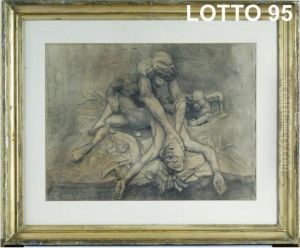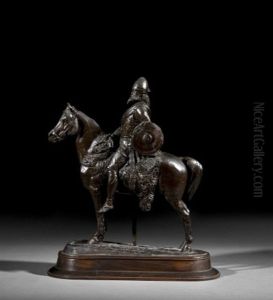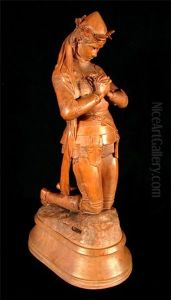Emmanuel Fremiet Paintings
Emmanuel Frémiet was a French sculptor who is renowned for his depiction of animals. Born in Paris on December 22, 1824, he was initially taught by his stepfather, who was a minor sculptor. His natural inclination and talent for the sculptural arts, especially animal subjects, became evident early on. Frémiet worked at the Muséum national d'Histoire naturelle in Paris, where he produced his first notable works and began to develop a reputation for the precision and lifelike quality of his sculptures.
His early works were primarily models of animals, which exhibited a level of detail and anatomical accuracy that distinguished him from many of his peers. Over time, Frémiet's work evolved to include historical and mythological figures, often integrating human figures with animals. His approach combined scientific observation with artistic creativity, which was quite innovative for the time and led to his recognition as a pioneer in the field of animalier sculpture, a genre focusing on the realistic portrayal of animals.
Frémiet's reputation grew steadily and he began to receive commissions for public monuments. One of his most famous works is the equestrian statue of Joan of Arc (Jeanne d'Arc), located in Place des Pyramides, Paris. This statue, unveiled in 1874, is notable for its dynamic representation of the heroine and her horse, capturing a sense of movement and heroism. Other notable works include the gilded equestrian statue of Saint Michael slaying the dragon atop the spire of Mont-Saint-Michel, and the bronze sculptures at the Jardin des Plantes in Paris.
Throughout his career, Frémiet received numerous awards and honors. He was awarded the Medal of Honor at the Salon in 1855 and 1859, and was made a Knight of the Legion of Honor in 1867. In 1892, he succeeded Antoine-Louis Barye as the chair of animal sculpture at the École des Beaux-Arts. Frémiet's influence extended well beyond his lifetime, as he is often regarded as a forerunner to modern animal sculpture and his works continue to be appreciated for their vigor and detail.
Emmanuel Frémiet passed away on September 10, 1910, in Paris. His legacy is preserved through the numerous sculptures that adorn public spaces and museums, as well as through the continued admiration for his ability to capture the essence of the animal kingdom and its interaction with humans. His work remains a reference point for sculptors and animaliers who followed in his footsteps.









